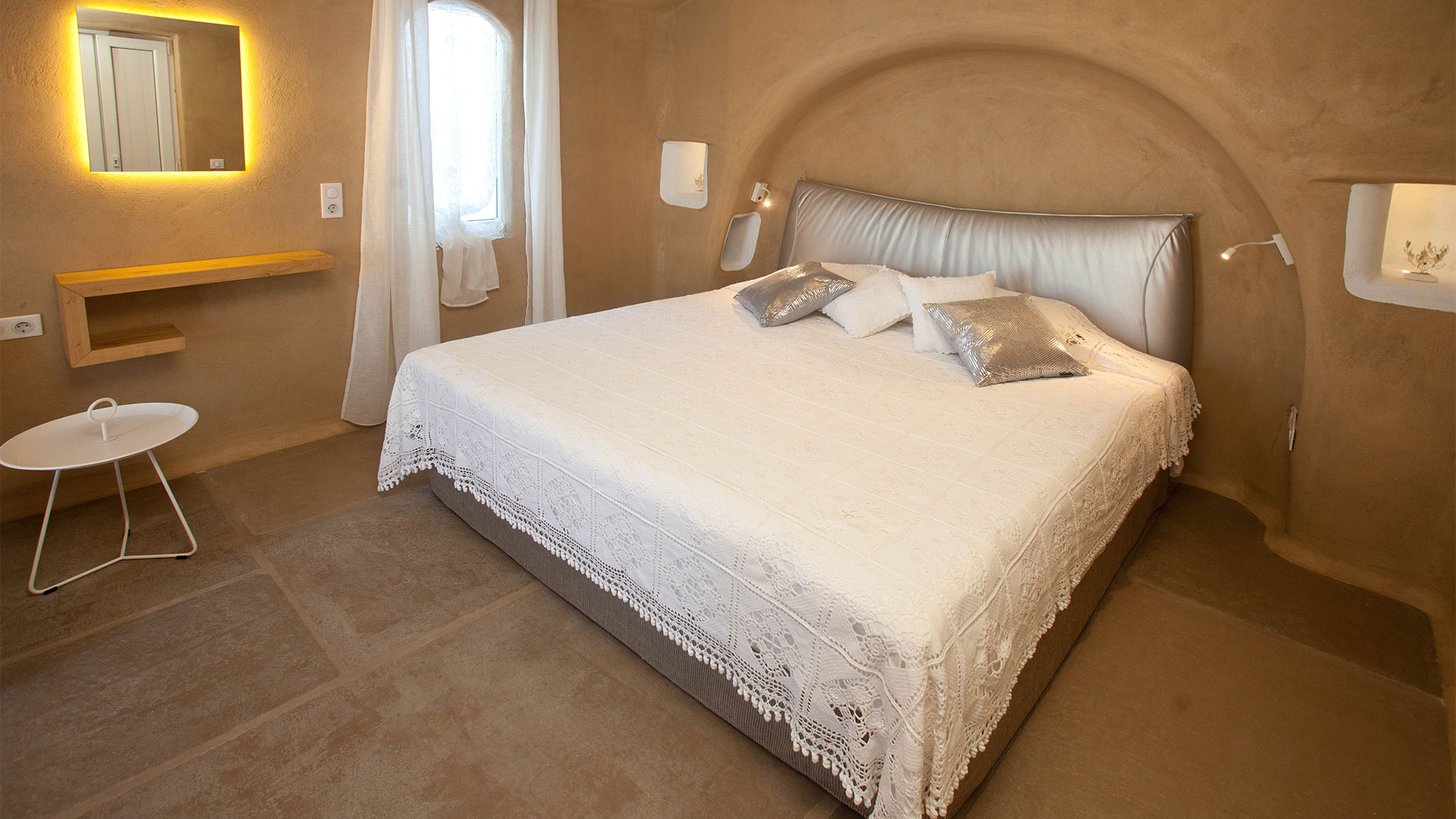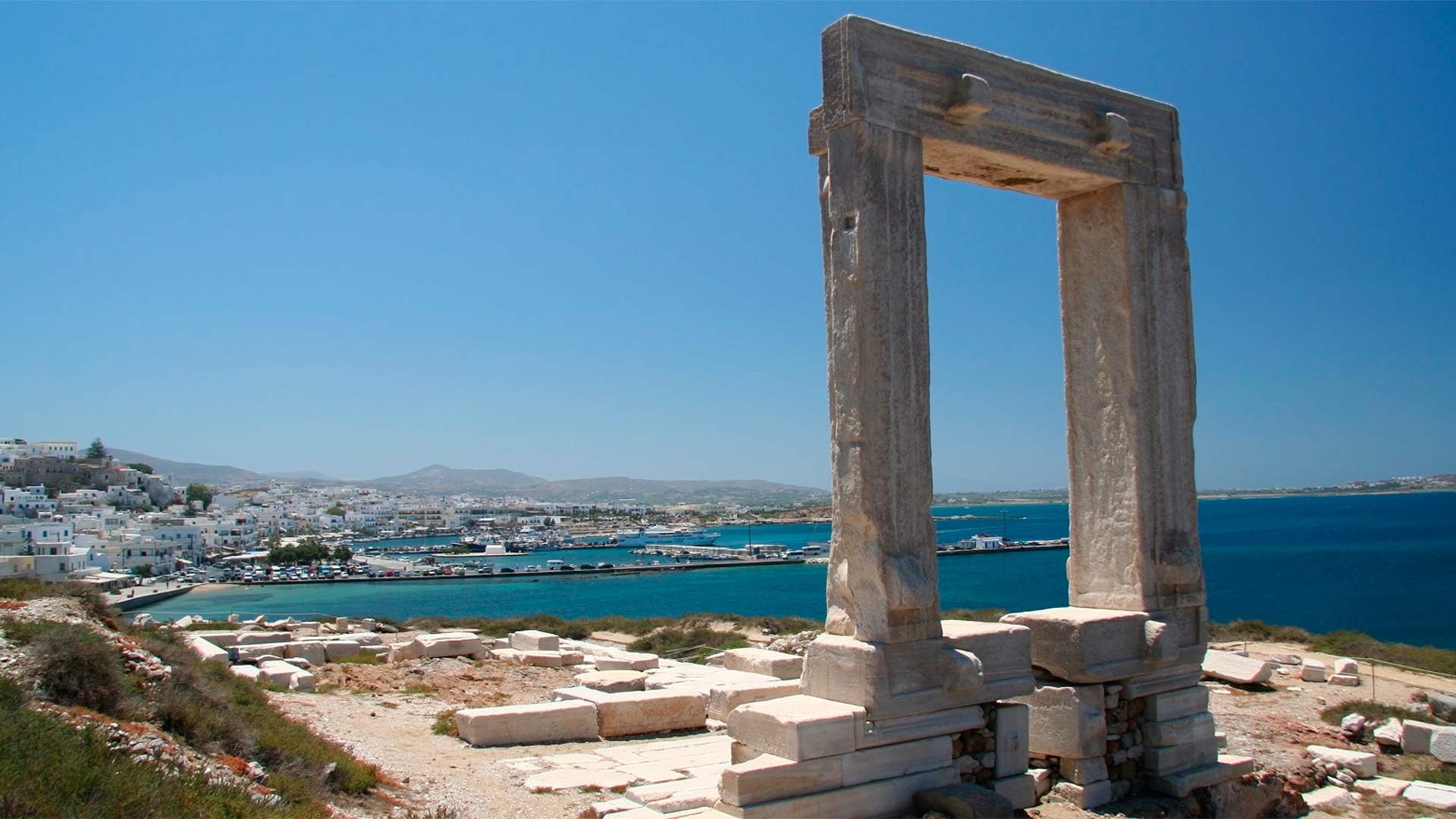
Portara
Portara, a symbol that arouses the interest of travelers from all over the world, remains a mystery that evokes wonder and wonder. This large marble gate, raised on the islet of Palatia, is undoubtedly the most famous and photographed spot of Naxos, a favorite stop for visitors who want to enjoy the enchanting sunset. Its impressive construction, combined with the majesty of its dimensions, creates a sense of eternity and mystery. It is an archaeological wonder that has divided researchers and visitors over its significance and history. Portara, as it is known, is the gate of an ancient temple that began to be built in the 6th BC. century, probably in honor of the god Apollo, on the island of Naxos. Its history is linked to the myth, as the islet it is located on, also known as the "island of Bacchus", is said to be the place where Theseus leaves Ariadne, after his departure from the island.

Archaeological Museum
The Archaeological Museum of Naxos is one of the treasures of our beautiful island. It stands out on the international stage due to its impressive collection of Proto-Cycladic figurines, which are undoubtedly the focus of interest. This historic building, which now houses the museum, is distinguished by its Venetian architecture, built during the centuries between 1600 and 1800. Inside the museum, you will discover on display finds from the Proto-Cycladic period, including figurines from Naxos , Kato Koufonisi and Keros. It also presents stirrups and other funerary objects from chamber tombs, from the Kamini tomb and Aplomata, as well as sculptures from various periods of Naxos history. Through these exhibits, the rich history and cultural heritage of the Aegean region is revealed.

Castles of Naxos
The castles of Naxos represent a rich and multi-layered history, with the Venetian Castle of Chora standing out as an outstanding example of medieval architecture. Built on the hill that functioned as a natural citadel, this castle forms the core of the city of Chora, offering a stunning view towards the sea. This building complex has the form of a medieval city with the outer walls of the peripheral houses forming the wall of the Castle.
Also impressive are the castles of Bazaio and Apaliros, which often host cultural events and festivals.
Another Naxian castle, Zeugoli Castle, built in the 7th century, highlights the rich history of the island. It is full of traditional Aegean arches, openings and balconies from where you can admire a wonderful view. Also, there are the museums of Epiranthos: archaeological, geological, natural history and folklore, with rich collections.
The ancient tower of Plaka, according to the myths and legends that prevail about it, was inhabited by the mysterious form of a fortune-teller-queen.
In addition, the tower of Chimarros is one of the most impressive historical monuments of Naxos. Built of marble with a height of 15 meters, it stands out for its round design.
At the same time, the Apaliros Castle, built during the Byzantine era, takes us on a journey through history, since at its foot was the capital of Byzantine Naxos.
The Apano Castle, which dominates the whole of central Naxos, includes monuments from the ancient, Byzantine and Venetian periods, highlighting the rich cultural landscape of the island.
Finally, the Venetian towers of the feudal period, built with the typical Naxos stone, represent the architectural offer of the region, with the towers of Belonia, Grazia, Markopolitis, Frangopoulos and Barotsi being the most prominent.

The Sanctuary of Dionysus in Yria
The Sanctuary of Dionysus in Yria is an ancient place of worship in the center of the Aegean, with a history that goes back centuries. One of the oldest holy places, starting from the 14th century BC, when the worship of Dionysus was established. From the ancient sanctuary of Dionysos, with the Ionic rhythms to the Christian era with the worship of Saint George, the area was a constant source of religious activity. The ruins of the sanctuary were only discovered in 1982 and since then they have been the subject of excavations and restorations. Today, it is one of the most well-kept archaeological sites in Greece. Furthermore, the route to the sanctuary of Dionysos crosses a rural landscape with orchards of Naxos potatoes, offering a different note to the exploration of our island. Finally, at the entrance of the sanctuary, there is a small archaeological collection, which can enhance the understanding of the history of the place.

The Temple of Demeter in Sagri
On top of a hill and in a fertile valley in Naxos, dominates the ancient Temple of Demeter goddess of harvest, sowing and fertility. Built around 530 BC. in Gyroula Sangriu, is one of the first Ionic temples and a living narrative of ancient faith and spirituality. The temple has experienced the centuries with a complex history. Initially, it was dedicated to Demeter, Apollo and Persephone, but over time it was converted into a Christian basilica. Thus, the ancient marbles of the church were used for the construction of the new Christian church of Saint John the Theologian. The restoration of the temple highlights the beauty and cultural wealth of the area, it gives you the opportunity to discover both sides of the monument, the ancient and the Christian. Also, the route to the temple is a journey through time, inspired by the beauty of nature and architectural magic.

Kouros Flerio and Kouros of Apollo
From the two ancient quarries of Naxos emerged one of the greatest arts of antiquity, marble sculpture, which is one of the top achievements of the archaic period. Thus, near these quarries, one can see unfinished kouros, which reflect a living testimony of the ancient art that pervades the island. One of them is located in the Flerio quarry outside the village of Melanes. There, a half-finished Kouros of supernatural size (10.4 meters), in the place where the ancient craftsmen left it, lies under a large tree. The right knee of this marble giant said to be Dionysus or Apollo is broken, leaving him lying on the ground. Despite its imperfect state, the statue of Kouros is a masterpiece of ancient sculpture, which leaves impressions of the way it was created and transported.
Continuing, at the northernmost point of our Naxos, in yet another ancient quarry near the settlement of Apollo, you will find the imposing Kouros of Apollo, from which the name of the picturesque fishing village "Apollonas" was derived. It is an impressive unfinished statue 10.7 meters high, made of light gray Naxos marble, weighing around 80 tons. Its construction dates from the beginning of the 7th/6th century BC. and is one of the most impressive monuments of the ancient period, reflecting the architecture and the special style of the time.
SPECIAL OFFERS

BOOK DIRECT AND WIN A SPECIAL DISCOUNT OF 10%
Book directly from our official website and get a special discount of 10%. Win additional discounts for full prepayment and non refundable rates.
We guarantee you will not find better rates for our hotel in any other website, worldwide.
Hurry Up, make your reservation soon. Limited number of rooms left.

STAY 7 OR MORE OVERNIGHTS AND WIN A SPECIAL DISCOUNT OF 15%
All reservations for 7 or more overnights get a special discount of 15%. Win additional discounts for full prepayment and non refundable rates. We guarantee you will not find better rates for our hotel in any other website, worldwide. Hurry Up, make your reservation soon. Limited number of rooms left.
DETAILS RESERVE NOW
JOIN OUR LOYALTY CLUB AND WIN A SPECIAL MEMBER DISCOUNT OF 5%
Register in our web booking engine and be part of our loyal customers club, enjoying a 5% special member discount. Win additional discounts for full prepayment and non refundable rates. We guarantee you will not find better rates for our hotel in any other website, worldwide. Hurry Up, make your reservation soon. Limited number of rooms left.
DETAILS RESERVE NOWOUR NEWS

Naxos gems
Naxos island, is located in the Cyclades complex of the Aegean sea. A hidden gem that offers visitors a unique blend of history, culture, and natural beauty. Visitors can explore many archaeological sites, including the Temple of Apollo.
VIEW MORE
Local Gastronomy
Naxos is the largest island of the Cycladic complex. Well known for beautiful beaches, ancient ruins, and traditional villages. But one of the island’s best secrets is the delicious local food.
VIEW MORE
The Olympic Flame in Naxos
On Tuesday April 16th , the touching of the Olympic Flame ceremony took place in Ancient Olympia. In the ruins of the temple of the goddess of marriage, Hera, the sun's rays lit the Olympic Flame.
VIEW MOREOUR REVIEWS

Naxos Golden Sun
84300 Stelida, Agios Prokopios
GR-Greece
Phone: +302285029040
e-mail for reservations: [email protected]
SUBSCRIBE TO OUR NEWSLETTER

Web booking Engine and Web Site development powered by Flexibook.
Do you like a similar website for your company? Click Here!
From
per day


Check-in
Check-out
Nights

Select a room
Standard Double
Standard Double Not Refundable
Studio Standard
Studio Standard Not Refundable
Junior Suite Sea View Double
Junior Suite Sea View Double Not Refundable
Junior Suite Sea View
Junior Suite Sea View Not Refundable
Family Suite Garden View
Family Suite Garden View Not Refundable
Honeymoon Suite with Indoor Jacuzzi
Honeymoon Suite with Indoor Jacuzzi Not Refundable
Honeymoon Suite with Outdoor Jacuzzi
Honeymoon Suite with Outdoor Jacuzzi Not Refundable
Family Suite Sea View
Family Suite Sea View Not Refundable
Executive Suite with Private Pool
Executive Suite with Private Pool Not Refundable
 Official Website Official Website |
|
|
|
€ 200 |
|
|
€ 200 |
|
|
€ 200 |
Reasons why book direct

Best price guarantee

Upgrades and privileges

Save Money
An Exquisite Oasis of Luxury and Serenity, Christos





Source: 
My stay at the Golden Sun Naxos Hotel was nothing short of extraordinary. This establishment not only offers opulence and comfort but also provides an unforgettable experience that will linger in my memories for years to come. If you're seeking a heavenly retreat on the enchanting island of Naxos, look no further than this exceptional hotel. I wholeheartedly recommend it to anyone in search of a truly luxurious and rejuvenating getaway. The rooms at the hotel are a haven of elegance and comfort. Finally The staff at Golden Sun Naxos Hotel are the epitome of hospitality. From the warm welcome at check-in to the attentive service throughout my stay especially miss Alexandra at the front desk always greeting you with a honest smile in her face and willingly to help you at any way possible!!
We found this to be a hidden gem and won’t hesitate to return some day! Mark Canada





Source: 
Rich and healthy breakfast, impeccable staff, who satisfied all the wishes of the guests with smile and courtesy, excellent training of reception staff, who also gave us further information to move comfortably in the archaeological area and the wider area. They all took care of us and treated us with excess care and respect!! We will remember them with love!!
Special hotel for making memories, Katarina United Kingdom





Source: 
Beautiful property. Absolutely loved the staff. The food was exceptional. Our stay was perfect. Not too far of a walk to the bus into the old town. Our hot tub was cleaned every day. Fresh bedding put on every day. We only left this morning and are already looking to book again.
A lovely family holiday at a comfortable hotel with excellent staff, Tracy United Kingdom





Source: 
Lovely apartments, nice pool, great breakfast and reasonably priced menu. Staff were exceptionally helpful and make a real effort to ensure you have the holiday you want to have. Caterina went out of her way to help with everything from itineraries, to nail salons!
Great location, great room and great service!,Tod M





Source: 
Couldn't be happier with our choice of the Golden Sun Hotel. We did a lot of research trying to find a home base for our family of 4 during our two night stay on Naxos. The Golden Sun was perfect. We rented a car. Parking was free and easy. All that Naxos had to offer was easily accessible. Great beaches close by. The rooms were spacious and clean. Breakfast was basic, but good enough to start our day. Pool was large and well kept. The service was amazing. We felt welcome from the moment we arrived. We have to thank Alexandra at the front desk for that. Alexandra was one of the friendliest people we ever met. Keep doing what you are doing at the Golden Sun. We hope to be back!
Amazing Stay!!!Emma M





Source: 
We cannot say enough good things about our stay at Golden Sun! The grounds, rooms, pool, and setting are stunning. The bed was extremely comfortable, air conditioning/wifi/shower worked perfectly! Everything was very clean, too. The location was spectacular as we had views of the town as well as close proximity to the most stunning, sandy beaches. We are two friends in our early twenties on holiday and found no shortage of fun things to do while staying here. We reccomend hiring an ATV to see the island and make your trip down to the beach less than 5 minutes! :)
Powered by


